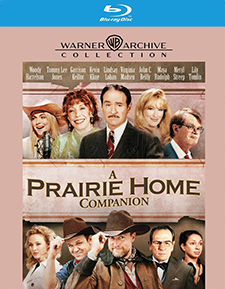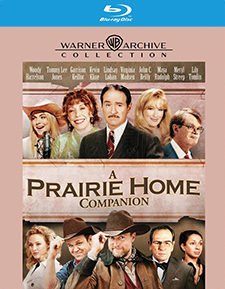Prairie Home Companion, A (Blu-ray Review)

Director
Robert AltmanRelease Date(s)
2006 (October 15, 2024)Studio(s)
New Line Cinema/Picturehouse (Warner Archive Collection)- Film/Program Grade: B+
- Video Grade: A
- Audio Grade: A
- Extras Grade: B+
Review
Director Robert Altman’s final film—he died about five months into its release—A Prairie Home Companion (2006) is best appreciated by Altman fans and particularly admirers of the National Public Radio/Garrison Keillor radio series upon which it is based. Looking at reviews on the IMDb and elsewhere, fans of the radio series generally loved it, Altman fans liked it, and pretty much everyone else loathed it. I found it slight, moderately diverting, but minor, and certainly no Nashville (1975).
Keillor himself wrote the screenplay, working from the premise of A Prairie Home Companion’s final show, that the radio station’s parent company is shutting down the quaint small-town variety program, with plans to demolish its longtime home, Saint Paul, Minnesota’s Fitzgerald Theater. (In reality, the radio series continued for ten more years, and the theater still stands.)
Altman’s film begins just prior to this live broadcast and ends when the show does, though there’s a strange coda at the very end. Keillor plays himself, more or less, though called G.K. An ensemble film, the story introduces several musical acts, including the Johnson Girls, sisters Yolanda (Meryl Streep) and Rhonda (Lily Tomlin), with Yolanda’s daughter, Lola (Lindsay Lohan) tagging along; corny cowboy duo Dusty (Woody Harrelson) and Lefty (John C. Reilly); elderly Chuck Akers (L.Q. Jones, his last film also); along with the radio series regulars, including Tim Russell, Sue Scott, and Tom Keith; and pregnant, frequently exasperated P.A. Molly (Maya Rudolph).
Self-styled private eye Guy Noir (Kevin Kline), a character from the radio series played in that medium by Keillor, watches over everything; he dresses and talks like a bad imitation of Raymond Chandler’s Philip Marlowe. Meanwhile, the show is visited by the ephemeral, otherworldly “Dangerous Woman” (Virginia Madsen), a comforting angel of death.
Though an avid listener of NPR programming, I never particularly embraced the whimsy of the radio series of A Prairie Home Companion, preferring the earlier, similarly wryly humorous radio shows of Bob & Ray, and likewise feel A Mighty Wind (2003), another performance-type ensemble with singer-songwriting actors, is more successful than Altman’s film. Unlike the better Altman ensemble cast films, I never once accepted any of the major players as real people; rather, they all seemed actorly caricatures. Meryl Streep has a fine singing voice, this two years prior to Mamma Mia!, when everyone seemed to first notice it, but her character plays like an acting exercise. To begin with, it would take more than an actor of Streep’s caliber to convince us that she and Tomlin were distantly related, let alone sisters. She affects a Minnesotan accent while Tomlin does not, Streep’s coming off like an imitation of Catherine O’Hara in an SCTV sketch.
The Kevin Kline character, played in Kline’s usual confident-dumb-guy manner in comedies, doesn’t work; he’s cartoonish, out of synch with the rest of the picture. Keillor’s screenplay apparently went through numerous drafts, Altman preferring to minimize Madsen’s role while Keillor and the actress lobbied to expand it. Hers works better than Kline’s, though the film’s peculiar, ambiguous ending could be interpreted myriad ways—maybe she’s looking for Altman himself?
A Prairie Home Companion was shot in 1080p/24fps high-def; theatrically many venues exhibited 35mm prints. In 2.39:1 ‘scope format, the presentation is mostly indistinguishable from 35mm, though it does look a tad video-y here and there. The DTS-HD Master Audio 5.1 Surround is excellent; Altman was more attentive than most directors when it comes to audio presentation. Optional English SDH are provided and the disc is Region-Free.
Surprisingly, Altman lived long enough to record an audio commentary track for the film, accompanied by Kevin Kline. He was so ill during the making of the film, much of it reportedly from a wheelchair, that its insurers insisted upon a standby director (Paul Thomas Anderson in this case) if Altman dropped dead. On the commentary he sounds healthy and hearty; I wonder when he recorded it?
Also included are 35 minutes of outtakes and rehearsal footage; Come Play With Us: A Feature Companion, a 49-minute behind-the-scenes documentary; Soundtrack Preview, little more than a collection of music excerpts running 36 minutes; and a trailer.
Fans of the original radio series should find much to like with this feature, which sort of preserves a record of the program’s essentials with some fictionalized backstage material. It lacks the richness of Altman’s best ensemble cast films, but it’s not a bad swan song, either.
- Stuart Galbraith IV

